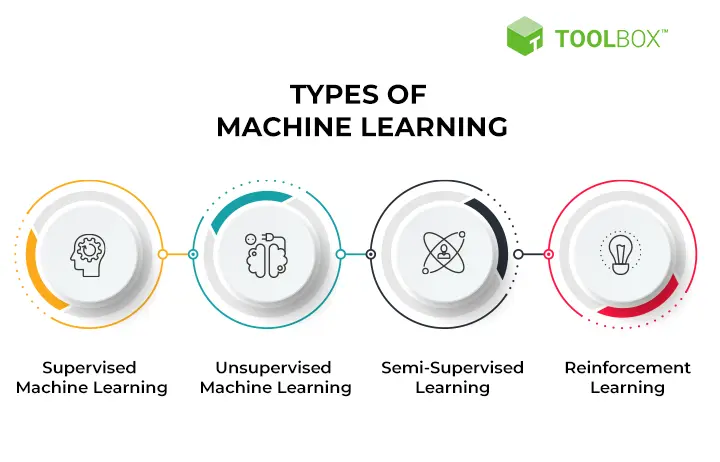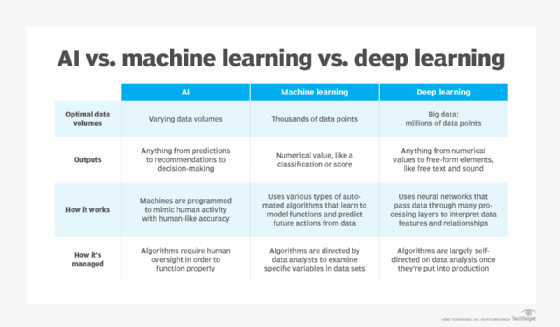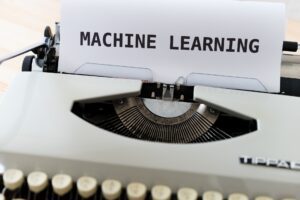- What is Machine Learning (ML)?
- Importance of Machine Learning in the Digital Era
- Understanding Machine Learning
- Types of Machine Learning
- Applications of Machine Learning
- Natural Language Processing (NLP)
- Significance of Machine Learning
- Machine Learning vs AI vs Deep Learning
- Reinforcement Learning
- How Machine Learning Works
- Top 5 Machine Learning Applications
- FAQs
What is Machine Learning (ML)?
In the dynamic and ever-evolving world of technology, Machine Learning (ML) has emerged as a transformative force, reshaping the way we approach problem-solving and decision-making. At its core, machine learning is a subset of artificial intelligence like meta Ai that enables computer systems to learn and improve from data, without being explicitly programmed. By feeding datasets to these systems and utilizing advanced algorithms, ML empowers them to identify patterns, make predictions, and automate processes, revolutionizing various industries and driving innovation.
Importance of Machine Learning in the Digital Era
Machine learning is essential in the digital era due to its ability to:
- Analyze large chunks of data: Machine learning algorithms can review large volumes of data and find specific trends and patterns that might not be apparent to humans4.
- Make predictions and classifications: Machine learning algorithms can make predictions or classifications based on input data, which can be labeled or unlabeled4.
- Improve continuously: As machine learning algorithms gain experience, they keep improving in accuracy and efficiency, enabling them to make better decisions4.
- Handle multi-dimensional and multi-variety data: Machine learning algorithms are good at handling data that are multi-dimensional and multi-variety, and can do this in dynamic or uncertain environments4.
- Provide personalized experiences: Machine learning holds the capability to help deliver much more personal experience to customers and also targeting the right customers
Understanding Machine Learning
Definition and Core Concepts
Machine learning is a field of artificial intelligence that enables computer systems to learn and improve from data without being explicitly programmed.
The core concepts of machine learning include:
- Data Preprocessing: Cleaning, transforming, and preparing data for analysis.
- Feature Engineering: Selecting and creating relevant features from raw data to improve model performance.
- Model Training: Applying algorithms to learn patterns and make predictions from the data.
- Model Evaluation: Assessing the performance and accuracy of the trained model.
- Model Deployment: Integrating the trained model into real-world applications and systems.
Comparison with Traditional Programming
- Traditional programming relies on explicit, rule-based instructions to solve problems.
- In contrast, machine learning algorithms learn from data, identifying patterns and relationships to make predictions or decisions.
- Machine learning models can adapt and improve over time as they are exposed to more data, whereas traditional programs require manual updates.
- Machine learning excels at tasks that are difficult to program explicitly, such as image recognition, natural language processing, and predictive analytics.
Evolution of Machine Learning
- It has evolved significantly over the past decades, driven by advancements in computing power, data availability, and algorithm development.
- Early machine learning techniques, such as linear regression and decision trees, laid the foundation for more complex models.
- The rise of deep learning, a subset of machine learning, has revolutionized fields like computer vision, speech recognition, and natural language processing.
- Ongoing research and development in areas like reinforcement learning, transfer learning, and unsupervised learning continue to expand the capabilities of machine learning.
- The integration of machine learning with other technologies, such as cloud computing and edge devices, has enabled the deployment of intelligent systems in various real-world applications.
By understanding the definition, core concepts, and evolution of machine learning, we can better appreciate its transformative impact on the digital era and its potential to drive innovation across industries.
Types of Machine Learning

Supervised Learning
Supervised learning is a type of machine learning where the model is trained on a labeled dataset, meaning the input data is accompanied by the corresponding output or target variable. The model learns a mapping between the input features and the output, and can then use this learned function to make predictions on new, unseen data.Some common examples of supervised learning algorithms include:
- Linear Regression: Predicting a continuous target variable, such as house prices based on features like size, location, and number of bedrooms.
- Logistic Regression: Classifying data into discrete categories, such as whether an email is spam or not.
- Decision Trees: Building a tree-like model of decisions and their possible consequences to classify data.
- Support Vector Machines (SVMs): Identifying the optimal hyperplane that separates different classes of data.
Use Cases and Applications
Supervised learning is widely used in a variety of applications, including:
- Image classification: Identifying objects, people, text, or other elements in digital images.
- Spam detection: Classifying emails as spam or not spam based on the content and other features.
- Sentiment analysis: Determining the sentiment (positive, negative, or neutral) expressed in text, such as product reviews or social media posts.
- Fraud detection: Identifying fraudulent transactions or activities based on patterns in financial data.
- Medical diagnosis: Predicting the likelihood of a patient having a certain disease based on their symptoms and medical history.
Unsupervised Learning
Unsupervised learning is a type of machine learning where the model is trained on an unlabeled dataset, meaning the input data does not have any corresponding output or target variable. The model’s goal is to discover hidden patterns, structures, or groupings within the data on its own.Some common examples of unsupervised learning algorithms include:
- K-Means Clustering: Grouping data points into k clusters based on their similarity.
- Principal Component Analysis (PCA): Reducing the dimensionality of a dataset while preserving as much of the variance as possible.
- Anomaly Detection: Identifying data points that are significantly different from the rest of the dataset.
Use Cases and Applications
Unsupervised learning is often used in applications where the goal is to explore and understand the underlying structure of the data, such as:
- Customer segmentation: Grouping customers based on their purchasing behavior, demographics, or other characteristics.
- Recommendation systems: Suggesting products, content, or services to users based on their preferences and the preferences of similar users.
- Anomaly detection: Identifying unusual or suspicious activities in financial transactions, network traffic, or sensor data.
- Image compression: Reducing the dimensionality of image data while preserving the most important features.
- Dimensionality reduction: Simplifying high-dimensional datasets for visualization or further analysis.
Reinforcement Learning
Reinforcement learning is a type of machine learning where an agent learns by interacting with an environment and receiving feedback in the form of rewards or penalties. The agent’s goal is to maximize the cumulative reward by taking actions that lead to the most favorable outcomes.Some common examples of reinforcement learning algorithms include:
- Q-Learning: An algorithm that learns the value of taking specific actions in a given state.
- Policy Gradient Methods: Algorithms that directly learn a mapping from states to actions that maximize the expected reward.
- Deep Q-Networks (DQN): A combination of deep learning and reinforcement learning, where a neural network is used to approximate the Q-function.
Use Cases and Applications
Reinforcement learning is particularly well-suited for applications where the environment is dynamic and the agent needs to make a sequence of decisions to achieve a goal, such as:
- Game playing: Training AI agents to play complex games like chess, Go, or video games.
- Robotics and control systems: Controlling the movements and actions of robots or other autonomous systems to achieve a desired outcome.
- Resource allocation and scheduling: Optimizing the allocation of resources, such as energy or transportation, to maximize efficiency.
- Personalized recommendations: Adapting recommendations based on a user’s interactions and feedback.
- Autonomous driving: Training self-driving cars to navigate safely and efficiently in real-world environments.
By understanding the different types of machine learning and their respective use cases, you can better identify the appropriate approach for your specific problem or application, and leverage the power of machine learning to drive innovation and solve complex challenges in the digital era.
Applications of Machine Learning
Healthcare
In the healthcare sector, It’s applications are revolutionizing patient care, diagnosis, and treatment. From predictive analytics for early disease detection to personalized treatment plans based on individual patient data, machine learning is enhancing medical outcomes and driving advancements in the field.
Finance
It has had a significant impact on the financial services industry, enabling more accurate predictions, better risk management, and improved customer experiences. Applications range from fraud detection and algorithmic trading to personalized financial recommendations and credit scoring.
Automotive
In the automotive industry, machine learning is transforming vehicle safety, autonomous driving, and predictive maintenance. From advanced driver assistance systems to self-driving cars, It’s algorithms are reshaping the future of transportation and enhancing road safety.
Retail
It applications in retail include personalized recommendations, demand forecasting, inventory management, and customer segmentation. By analyzing vast amounts of data, retailers can optimize pricing strategies, improve customer engagement, and enhance the overall shopping experience.
Natural Language Processing (NLP)
Natural Language Processing (NLP) powered by machine learning enables computers to understand, interpret, and generate human language. Applications include chatbots, sentiment analysis, language translation, and voice recognition, enhancing communication and interaction between humans and machines.
Significance of Machine Learning
Impact on Industries and Society
It’s impact on industries and society is profound, driving innovation, efficiency, and transformative change. By enabling data-driven decision-making, automating processes, and unlocking insights from complex datasets, machine learning is reshaping how businesses operate and how individuals interact with technology.
Role in Driving Innovation and Efficiency
It plays a crucial role in driving innovation and efficiency across various sectors. By leveraging advanced algorithms and predictive analytics, organizations can optimize operations, improve customer experiences, and unlock new opportunities for growth and development.
Machine Learning vs AI vs Deep Learning
Differentiating Between AI, Machine Learning, and Deep Learning
Artificial Intelligence (AI) is the broader concept of machines being able to carry out tasks in a way that we would consider “smart.” Machine learning is a subset of AI that focuses on the development of algorithms that can learn from and make predictions based on data. Deep learning is a subset of machine learning that uses neural networks with many layers to model and process data.

Understanding the Relationship and Applications
AI encompasses machine learning and deep learning, with each playing a distinct role in enabling intelligent systems. Machine learning algorithms learn from data to make predictions, while deep learning models mimic the human brain’s neural networks to process complex information and patterns.
Reinforcement Learning
Definition and Overview
Reinforcement learning is a type of it where an agent learns to make decisions by interacting with an environment and receiving feedback in the form of rewards or penalties. The agent’s goal is to maximize the cumulative reward by taking actions that lead to favorable outcomes.
Applications and Use Cases
Reinforcement learning is applied in various domains, including game playing, robotics, resource allocation, and personalized recommendations. By learning from trial and error, reinforcement learning algorithms can adapt to dynamic environments and optimize decision-making processes.
How Machine Learning Works
Training Models
It models are trained on labeled data through algorithms that learn patterns and relationships. The training process involves feeding data into the model, adjusting parameters, and optimizing performance to make accurate predictions on new, unseen data. like Meta’s Ai mdel LLama 3
Making Predictions
Once trained, machine learning models can make predictions or decisions based on new input data. By applying the learned patterns and relationships, the model can generate insights, classify data, or forecast outcomes in real-time applications.
Iterative Learning Process
Machine learning involves an iterative learning process where models are continuously refined and improved over time. By analyzing feedback, adjusting parameters, and retraining on new data, machine learning systems evolve and adapt to changing environments and requirements.
Top 5 Machine Learning Applications
Healthcare
Machine learning applications in healthcare include
- personalized treatment plans
- drug discovery
- predictive analytics for disease diagnosis
- patient monitoring systems.
Finance
In finance, machine learning is used for
- fraud detection
- algorithmic trading
- credit scoring
- risk management
- personalized financial recommendations.
Computer Vision
Computer vision applications powered by machine learning enable
- image recognition
- object detection
- facial recognition
- autonomous driving systems.
In conclusion, it’s impact on industries and society is transformative, driving innovation, efficiency, and growth across diverse sectors. By differentiating between AI, machine learning, and deep learning, understanding reinforcement learning, and exploring top applications, we can appreciate the potential and significance of machine learning in shaping the future of technology and human interaction.
FAQs
What is Machine Learning?
Machine learning is a subset of artificial intelligence that enables computer systems to learn and improve from data without being explicitly programmed. It empowers systems to identify patterns, make predictions, and automate processes, revolutionizing various industries and driving innovation.
What are the Key Features of Machine Learning?
Machine learning algorithms can analyze large chunks of data, make predictions and classifications, improve continuously, handle multi-dimensional and multi-variety data, and provide personalized experiences.
How Does Machine Learning Differ from Traditional Programming?
Traditional programming relies on explicit, rule-based instructions to solve problems. In contrast, machine learning algorithms learn from data, identifying patterns and relationships to make predictions or decisions. Machine learning models can adapt and improve over time as they are exposed to more data, whereas traditional programs require manual updates.
What are the Different Types of Machine Learning?
There are three main types of machine learning: supervised learning, unsupervised learning, and reinforcement learning. Supervised learning involves training models on labeled data to make predictions on new, unseen data. Unsupervised learning involves training models on unlabeled data to discover hidden patterns or groupings. Reinforcement learning involves training agents to make decisions by interacting with an environment and receiving feedback in the form of rewards or penalties.
What is the Future of Machine Learning?
The future of machine learning is exciting and rapidly evolving. With advancements in computing power, data availability, and algorithm development, machine learning is expected to continue revolutionizing various industries and transforming the way we live and work.





